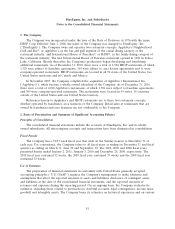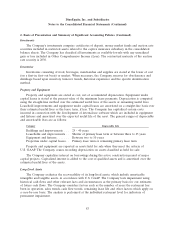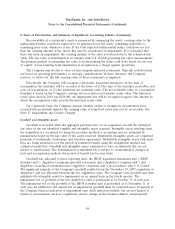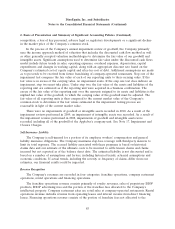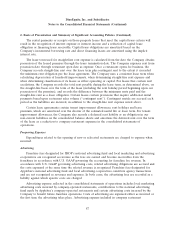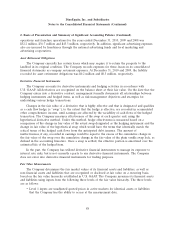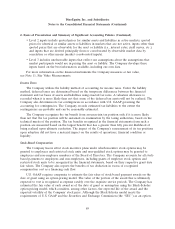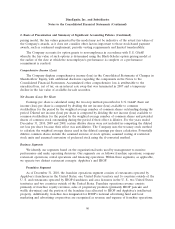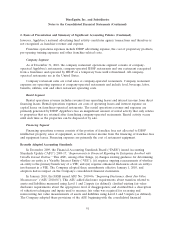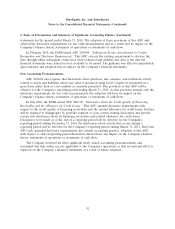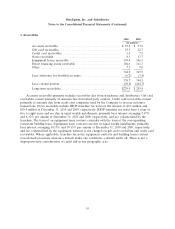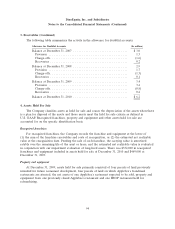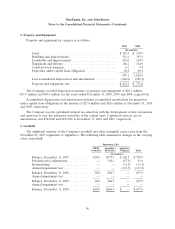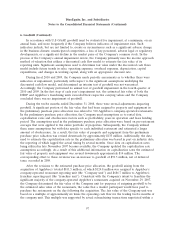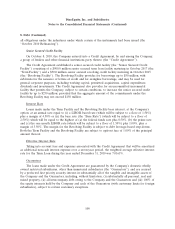IHOP 2010 Annual Report Download - page 107
Download and view the complete annual report
Please find page 107 of the 2010 IHOP annual report below. You can navigate through the pages in the report by either clicking on the pages listed below, or by using the keyword search tool below to find specific information within the annual report.DineEquity, Inc. and Subsidiaries
Notes to the Consolidated Financial Statements (Continued)
2. Basis of Presentation and Summary of Significant Accounting Policies (Continued)
however, Applebee’s national advertising fund activity constitutes agency transactions and therefore is
not recognized as franchise revenue and expense.
Franchise operations expenses include IHOP advertising expense, the cost of proprietary products,
pre-opening training expenses and other franchise-related costs.
Company Segment
As of December 31, 2010, the company restaurant operations segment consists of company-
operated Applebee’s restaurants, company-operated IHOP restaurants and one restaurant reacquired
from a franchisee and operated by IHOP on a temporary basis until refranchised. All company-
operated restaurants are in the United States.
Company restaurant sales are retail sales at company-operated restaurants. Company restaurant
expenses are operating expenses at company-operated restaurants and include food, beverage, labor,
benefits, utilities, rent and other restaurant operating costs.
Rental Segment
Rental operations revenue includes revenue from operating leases and interest income from direct
financing leases. Rental operations expenses are costs of operating leases and interest expense on
capital leases on franchisee-operated restaurants. The rental operations revenue and expenses are
primarily generated by IHOP. Applebee’s has an insignificant amount of rental activity that only relates
to properties that are retained after franchising company-operated restaurants. Rental activity occurs
until such time as the properties can be disposed of by sale.
Financing Segment
Financing operations revenue consists of the portion of franchise fees not allocated to IHOP
intellectual property, sales of equipment, as well as interest income from the financing of franchise fees
and equipment leases. Financing expenses are primarily the cost of restaurant equipment.
Recently Adopted Accounting Standards
In December 2009, the Financial Accounting Standards Board (‘‘FASB’’) issued Accounting
Standards Update (‘‘ASU’’) 2009-17, ‘‘Improvements to Financial Reporting by Enterprises Involved with
Variable Interest Entities.’’ This ASU, among other things, (i) changes existing guidance for determining
whether an entity is a Variable Interest Entity (‘‘VIE’’); (ii) requires ongoing reassessments of whether
an entity is the primary beneficiary of a VIE; and (iii) requires enhanced disclosures about an entity’s
involvement in a VIE. The Company adopted these amendments effective January 1, 2010, and
adoption had no impact on the Company’s consolidated financial statements.
In January 2010, the FASB issued ASU No. 2010-06, ‘‘Improving Disclosures About Fair Value
Measurement’’ (‘‘ASU 2010-06’’). This ASU added disclosure requirements about transfers related to
assets and liabilities measured using Level 1 and 2 inputs (as defined); clarified existing fair value
disclosure requirements about the appropriate level of disaggregation; and clarified that a description
of valuation techniques and inputs used to measure fair value was required for recurring and
nonrecurring fair value measurements of assets and liabilities using Level 2 and 3 inputs (as defined).
The Company adopted these provisions of the ASU beginning with the consolidated financial
91


